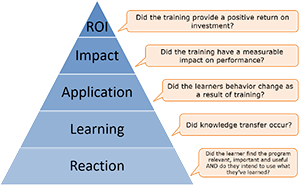Applying the Phillips ROI Process
Jump Simulation has established an ROI Committee made up of representatives from Performance Improvement, Healthcare Analytics, Business Development, Finance and Nursing and Clinical Education. They have the task of placing value on our highest rated educational programs using the Phillips model which evaluates projects in five levels: Reaction, Learning, Application, Impact and ROI. We used the Phillips model to measure the value of our Central Venous Catheter (CVC) program. The project looked to determine whether simulated central line training could lower rates of complications that are common with this procedure and lower health care costs.
The first level, Reaction, gauges whether learners find certain simulations relevant to their work and whether they intend to utilize what they’ve experienced in their practice. In a post event survey, learners in the CVC program provided positive feedback on the usefulness of this particular simulation.
The next level of the Phillips model, Learning, determines if simulation participants gained knowledge, skills and confidence from their experience. This means learners should be able to demonstrate new procedures in a simulated environment. As part of the data collected for the CVC study, direct observation of learners showed they performed simulated central line insertions correctly. A self-efficacy survey also showed improved confidence among those who participated in the simulation.
Application is the third level of evaluation in the ROI process. We want learners to not only demonstrate they can perform a certain task within a simulated environment; we also want to ensure those who participate in simulation apply that knowledge in the clinical space. A chart review of CVC simulation participants showed an increased percentage of successful line placements for patients within the Medical Intensive Care Unit (MICU) of OSF Saint Francis Medical Center.
The next question we want answered is whether simulation training has a measurable Impact on performance. Data is collected for this fourth level of the model by determining whether the simulation has helped OSF meet a strategic goal such as improved patient outcomes or increasing employee satisfaction. Chart review and billing and coding analysis of CVC simulation learners found that improved outcomes led to patients being able to go home sooner—by a little more than two days.
To learn about the fifth level of ROI, read the full article on the Jump website today!









